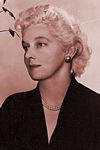Rosamond Nina Lehmann 1901 - 1990
May 12, 2010
 {::}**Rosamond
Nina Lehmann**
CBE 1901 - 1990 was a British
novelist.
{::}**Rosamond
Nina Lehmann**
CBE 1901 - 1990 was a British
novelist.
Rosamond Lehmann was a close friend of Wellesley Tudor Pole, whose many private letters to Rosamond were published as My Dear Alexias in 1979,
Rosamond Lehmann was the granddaughter of Robert Chambers, who wrote the _Vestiges of the Natural History of Creation. _
Rosamond Lehmann also a friend of John Maynard Keynes 1st Baron Keynes, Virginia Woolf, and her illustrious family knew Marie Comtesse d’Agoult, Robert Browning, William Benjamin Carpenter, John Chapman, Frederic Chopin, George Combe, Charles Darwin, Charles Dickens, George Eliot, Charles Francois Gounod, Spencer Timothy Hall, Jenny Lind, Franz Liszt, Camille Pissarro, Clara Schumann, Walter Scott,
Rosamond Nina Lehmann was born in Bourne End, Buckinghamshire, as the second daughter of Rudolph Chambers Lehmann and his wife Alice Davis, a New Englander. Her father Rudolph Chambers Lehmann was a liberal MP, and editor of the Daily News. John Lehmann was her brother; one of her two sisters was the famous actress Beatrix Lehmann.
In 1919 she went to Girton College, University of Cambridge to read English Literature, an unusual thing for a woman to do at that time. In December 1923 she married Leslie Runciman (later 2nd Viscount Runciman of Doxford), and the couple went to live in Newcastle upon Tyne. It was an unhappy marriage, and they separated in 1927 and were divorced later that year.
In 1927, Lehmann published her first novel, Dusty Answer, to great critical and popular acclaim. The novel’s heroine, Judith, is attracted to both men and women, and interacts with fairly openly gay and lesbian characters during her years at Cambridge. The novel was a succès de scandale.
Though none of her later novels were as successful as her first, Lehmann went on to publish six more novels, a play (No More Music, 1939), a collection of short stories (The Gypsy’s Baby & Other Stories, 1946), a spiritual autobiography (The Swan in the Evening, 1967), and a photographic memoir of her friends (Rosamond Lehmann’s Album, 1985), many of whom were famous Bloomsbury figures such as Leonard and Virginia Woolf, Dora Carrington, and Lytton Strachey.
She also translated two French novels into English: Jacques Lemarchand’s Genevieve (1948) and Jean Cocteau’s Children of the Game (1955). Her novels include A Note in Music (1930), Invitation to the Waltz (1932), The Weather in the Streets (1936), The Ballad and the Source (1944), The Echoing Grove (1953), and A Sea-Grape Tree (1976).
In 1928, Lehmann married Wogan Philipps, an artist (and the only member of the Communist Party of Great Britain ever to sit in the House of Lords). They had two children, a son Hugo (1929-1999) and a daughter Sarah or Sally (1934-1958), but the marriage quickly fell apart during the late Thirties with her Communist husband leaving to take part in the Spanish Civil War.
During World War II she helped edit and contributed to New Writing, a periodical edited by her brother. She had an affair with Goronwy Rees (a Marxist intellectual, and in contact with the Cambridge Five spy ring through Guy Burgess. Right at the end of his life he admitted spying for the USSR for a short time) and then a “very public affair” for nine years (1941-1950) with the married Cecil Day Lewis (an Irish poet and the British Poet Laureate from 1968 until his death in 1972. He also wrote mystery stories under pseudonym of Nicholas Blake. **During the Second World War he worked as a publications editor in the Ministry of Information)**, who eventually left her for his second wife.
Her 1953 novel The Echoing Grove was made into the 2002 film Heart of Me, with Helena Bonham Carter as the main character, Dinah. Her book The Ballad and the Source depicts an unhappy marriage from the point of view of a child, and has been compared to Henry James junior’ What Maisie Knew.
The Swan in the Evening (1967) is an autobiography which Lehmann described as her “last testament”. In it, she intimately describes the emotions she felt at the birth of her daughter Sally, and also when Sally died abruptly of poliomyelitis at the age of 23 (or 24) in 1958 while in Jakarta. She never recovered from Sally’s death.
Lehmann claimed to have had some psychic experiences, documented in Moments of Truth.
Lehmann was awarded the CBE in 1982 and died at Clareville Grove, London on 12 March 1990, aged 89.
Of interest:
In 1829, here were three homeopathic Lehmanns, one at Coethen (Kothen) who was Samuel Hahnemann’s assistant; one at Zwickau, and the surgeon Lehmann, of Dresden.
Charles Frederick G Lehmann was a pupil of Samuel Hahnemann,
J Gottlob Lehmann 1788 - 1865, was a pupil of Samuel Hahnemann, Lehmann of Kothen was Samuel Hahnemann’s Pharmacist,
In 1866, the Lehmann family settled in London and became British citizens:
Amelia Lehmann was a daughter of Robert Chambers, (married to Rudolf Lehmann),
Janet Nina Lehmann was a daughter of Robert Chambers, (married to Frederick Augustus Lehmann), father of Rudolf Chambers Lehmann,
John Frederick Lehmann 1907 - 1987, son of **Rudolph Chambers Lehmann, **brother of **Rosemond Lehmann, **was an English poet and man of letters, and a friend of Virginia Woolf (and managing director of Hogarth Press between 1938 and 1946),
Liza Lehmann 1862 - 1918, daughter of Amelia Chambers and **Rudolf Lehmann**, was an English operatic soprano and composer, and a friend of Jenny Lind, Clara Schumann,
Rudolph Chambers Lehmann 1856 – 1929, son of Janet Nina Chambers and Frederick Augustus Lehmann, father of Rosamond Nina Lehman, was an English writer and Liberal Party politician,and he was a friend of Robert Browning, Charles Dickens, George Eliot,
Henri Lehmann 1814 – 1882, uncle of Rudolph Chambers Lehmann, was a German born French historical painter and portraitist and he painted Marie Comtesse d’Agoult, Frederic Chopin, Charles Francois Gounod, Franz Liszt, and he taught Camille Pissarro,